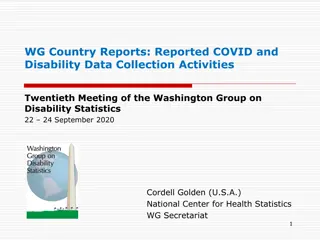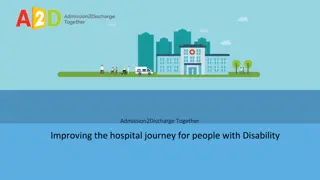Understanding Victimisation of People with Disability in NSW
This study explores the victimisation of people with disabilities in NSW, utilizing data from the National Disability Data Asset Pilot project. The research team identified the proportion of people with disabilities who are victims of crime and those who have been recorded as victims. Two main cohorts were studied: individuals in contact with disability services and support and those recorded as crime victims by the NSW Police Force. The study sheds light on the challenges faced by individuals with disabilities in relation to crime victimisation.
Download Presentation

Please find below an Image/Link to download the presentation.
The content on the website is provided AS IS for your information and personal use only. It may not be sold, licensed, or shared on other websites without obtaining consent from the author. Download presentation by click this link. If you encounter any issues during the download, it is possible that the publisher has removed the file from their server.
E N D
Presentation Transcript
The victimisation of people with disability in NSW: Results from the National Disability Data Asset Pilot National Disability Data Asset Pilot NSW Justice Test Case
This work was supported by the Commonwealth Government through the NDDA pilot project. Project team Project team Research team NSW Bureau of Crime Statistics and Research (BOCSAR) Research team NSW Bureau of Crime Statistics and Research (BOCSAR) Suzanne Poynton (Principal Investigator), Clare Ringland, Stewart Boiteux Research team Centre Forensic Behavioural Science (CFBS), Swinburne University of Technology Research team Centre Forensic Behavioural Science (CFBS), Swinburne University of Technology Rachael Fulham, Anne Sophie Pichler, Caleb Lloyd, Margaret Nixon Aboriginal Perspectives Expert Panel Aboriginal Perspectives Expert Panel Deborah Nanschild (Facilitator), Caroline Atkinson (We Al-Li), Damian Griffis (First Peoples Disability Network), Eileen Baldry (UNSW), Peta Macgillivray (Aboriginal Legal Service Board Yuwaya Ngarra-li Partnership), Mark Munnich (Aboriginal Legal Service) Implementation teams Implementation teams Celia Walker (NSW DCS), Ana Sartbayeva (DSS), Jo Maning (DSS), Seb Dunne (AIHW), Ximena Camacho (NPT) Advisory project team members Advisory project team members Julian Trollor (UNSW), Philip Snoyman (NSW Corrective Services)
QUESTION 1 BACKGROUND METHOD QUESTION 2 What proportion of people with disability are victims of crime? What proportion of victims of crime have a disability? What is the National Disability Data Asset Pilot? How did we identify people with disability? 3
There were two cohorts of interest for this study. There were two cohorts of interest for this study. All people in contact with at least one core disability service and support between 2009 and 2018: National Disability Insurance Scheme (NDIS), state-based disability services (pre-NIDS) and Disability Support Pension (DSP). Disability Cohort All people who were recorded as a victim of a crime reported to the NSW Police Force. Victim data were obtained from the NSW Computerised Operational Policing System (COPS) and for this study included incidents that occurred between 2014 and 2018. Victim Cohort 4
There were several research questions for each cohort. There were several research questions for each cohort. 1. What proportion of people with disability are victims of crime? 2. What factors are associated with an increased risk of a person with disability being a victim of crime? Disability Cohort 1. What proportion of victims of crime have a disability? 2. What are the characteristics of incidents involving people with disability (cf. those with no disability identified)? 3. Are incidents involving people with disability as likely to result in a person being proceeded against by police? Victim Cohort 4. Are people with disability more likely to experience repeat victimization than people with no disability identified? 5
There were several key research questions for each cohort. There were several key research questions for each cohort. 1. What proportion of people with disability are victims of crime? 2. What factors are associated with an increased risk of a person with disability being a victim of crime? Disability Cohort 1. What proportion of victims of crime have a disability? 2. What are the characteristics of incidents involving people with disability (cf. those with no disability identified)? 3. Are incidents involving people with disability less likely to result in a person being proceeded against by police? Victim Cohort 4. Are people with disability more likely to experience repeat victimization than people with no disability identified? 6
QUESTION 1 BACKGROUND METHOD QUESTION 2 What proportion of people with disability are victims of crime? What proportion of victims of crime have a disability? What is the National Disability Data Asset Pilot? How did we identify people with disability? 7
The final study sample includes records for 1.4 million individuals. The final study sample includes records for 1.4 million individuals. 92,370 people (aged 15+ at 31/12/2013) receiving disability services/supports AND victims of a crime reported to NSW police 890,138 people with a victim incident between 2014-2018 542,388 people receiving disability services or supports between 2009-2018 17.0% of people with disability were victims of crime 17.0% of people with disability were victims of crime 8
People with disability People with disability who are victims of crime: victims of crime: disability type disability type Cognitive Physical Psychosocial Total disability 25 (%) 20 19 20 17 17 15 9 9 10 7 6 6 5 4 4 5 0 Any crime Violent crime DV-related crime 1 in 5 people with cognitive or psychosocial disability were a victim of crime between 2014 1 in 5 people with cognitive or psychosocial disability were a victim of crime between 2014- -2018 2018 Nearly 1 in 10 people with cognitive or psychosocial disability were victims of violent crime Nearly 1 in 10 people with cognitive or psychosocial disability were victims of violent crime 9
People with disability People with disability who are victims of crime: victims of crime: Aboriginality Aboriginality Any crime Violent crime DV-related crime 45 39 40 34 35 30 25 19 18 20 16 16 15 15 9 10 6 6 5 3 5 0 Female/non-Aboriginal Female/Aboriginal Male/Non-Aboriginal Male/Aboriginal 1 in 3 Aboriginal women with disability were a victim of crime within the 5 1 in 3 Aboriginal women with disability were a victim of crime within the 5- -year period year period Aboriginal males also had higher rates of victimisation than non Aboriginal males also had higher rates of victimisation than non- -Aboriginal males and females Aboriginal males and females 10
People with disability People with disability who are victims of crime: victims of crime: Age Age Any crime Violent crime DV-related crime 30 24 25 22 22 22 20 15 13 15 11 11 10 9 8 8 10 7 6 5 3 5 2 1 0 15-19 20-29 30-39 40-49 50-59 60-69 Rates of victimisation decreased with increasing age Rates of victimisation decreased with increasing age 22% of 15 22% of 15- -19 year 19 year olds olds with disability were a victim of crime within the 5 with disability were a victim of crime within the 5- -year period year period 10% of 60 10% of 60- -69 year 69 year olds olds with disability were a victim of crime within the 5 with disability were a victim of crime within the 5- -year period year period 11
QUESTION 1 BACKGROUND METHOD QUESTION 2 What proportion of people with disability are victims of crime? What proportion of victims of crime have a disability? What is the National Disability Data Asset Pilot? How did we identify people with disability? 12
The final study sample includes records for 1.4 million individuals. The final study sample includes records for 1.4 million individuals. 96,112 people receiving disability services/supports AND victims of a crime reported to NSW police 890,138 people with a victim incident between 2014-2018 542,388 people receiving disability services or supports between 2009-2018 11.0% of all victims of crime were identified with disability 11.0% of all victims of crime were identified with disability 13
Victims of crime Victims of crime who have a disability disability Disability cohort Other disability identifier No disability identified 90 82 80 72 69 70 60 50 40 30 17 16 15 20 12 11 7 10 0 Any crime Violent crime DV-related crime 11% 11% - - 18% of victims of crime were identified as having a disability 18% of victims of crime were identified as having a disability 12% 12% - - 28% of victims of violent crime were identified as having a disability 28% of victims of violent crime were identified as having a disability 15% 15% - - 32% of victims of DV crime were identified as having a disability 32% of victims of DV crime were identified as having a disability 14
Victims of crime Victims of crime who have a incidents incidents who have a disability: disability: characteristics of characteristics of SOCIOECONOMIC STATUS RESIDENCE VIOLENT OFFENCES Victims residing in areas of greater Victims residing in regional areas Incidents involving people with socioeconomic disadvantage more more likely to have a disability disability more often violent and DV- likely to have a disability related ABORIGINALITY ALCOHOL Incidents involving people with Aboriginal victims of crime more disability more likely to be flagged as likely to have a disability alcohol related 15 15
Victims of crime Victims of crime who have a disability: disability: Aboriginality Aboriginality Disability cohort Other disability identifier No disability identified 90 81 76 80 70 55 60 51 50 40 31 30 23 22 18 20 13 13 11 7 10 0 Female/non-Aboriginal Female/Aboriginal Male/Non-Aboriginal Male/Aboriginal Using the expanded indicator, in around 40% of incidents involving an Aboriginal victim the victim Using the expanded indicator, in around 40% of incidents involving an Aboriginal victim the victim was identified with disability was identified with disability This compares with 23% of incidents where the victim was a non This compares with 23% of incidents where the victim was a non- -Aboriginal person Aboriginal person 16
Victims of violent crime Victims of violent crime who have a disability: police proceedings : police proceedings 38% of incidents involving people in the disability cohort, 42% involving other people with disability, 38% of incidents involving people in the disability cohort, 42% involving other people with disability, and 43% of those with no disability identified resulted in a POI being proceeded against. and 43% of those with no disability identified resulted in a POI being proceeded against. Percentages were lower for incidents involving victims with cognitive disabilities (alone or in Percentages were lower for incidents involving victims with cognitive disabilities (alone or in combination with other disability types) versus those with physical and/or psychosocial, or combination with other disability types) versus those with physical and/or psychosocial, or unspecified disabilities. unspecified disabilities. * Logistic regression model 17 *Adjusted for year, Aboriginality, age, area of residence, incident type, reporting date, number of victims, number of incidents, prior victimisation, prior offending, prior health contacts
Victims of violent crime Victims of violent crime who have a disability: : revictimisation revictimisation Nearly 1 in 5 victims of violent crime who have a disability experienced another incident within 12 months Nearly 1 in 5 victims of violent crime who have a disability experienced another incident within 12 months Rates of violent revictimization highest for those with both cognitive and psychosocial disability (25 Rates of violent revictimization highest for those with both cognitive and psychosocial disability (25- -26%) 26%) * Logistic regression model 18 *Adjusted for year, Aboriginality, age, area of residence, incident type, reporting date, number of victims, number of incidents, prior victimisation, prior offending, prior health contacts
QUESTION 1 BACKGROUND METHOD QUESTION 2 What proportion of people with disability are victims of crime? What proportion of victims of crime have a disability? What is the National Disability Data Asset Pilot? How did we identify people with disability? 19
QUESTION 1 What proportion of people with disability are victims of crime? Of all people with disability in NSW: 17% were a victim of any crime (20% for cognitive/psychosocial disorders) 7% were a victim of violent crime (9% for cognitive/psychosocial disorders) 4% were a victim of DV-related crime (5%-6% for cognitive/psychosocial disorders) Of all Aboriginal people with disability in NSW: 34% of women were a victim of crime (18% violent, 19% DV related) 29% of men were a victim of crime (15% violent, 9% DV related) Of all people with disability aged 15-19 in NSW: 22% were a victim of crime (13% violent, 8% DV related) 20
QUESTION 2 What proportion of victims of crime experience disability? People with disability comprised: 11%-18% of all victims of crime 12%-28% of all victims of violent crime 15%-32% of all victims of DV-related crime Around 40% of all Aboriginal victims of crime Persons of interest were less likely to be proceeded against when incidents involved people with disability (esp. violence) Differences in police action rates particularly pronounced for people with both cognitive and physical disabilities. People with disability more likely to experience violent and DV-related revictimisation Those with cognitive and/or psychosocial disabilities at greater risk of revictimisation than those with other or no known disabilities. 21
GET IN TOUCH 6 Parramatta Square Level 5, 10 Darcy St, Sydney NSW 2000 (02) 8346 1100 bcsr@justice.nsw.gov.au https://www.bocsar.nsw.gov.au/ @BOCSAR NSWBOCSR 22























